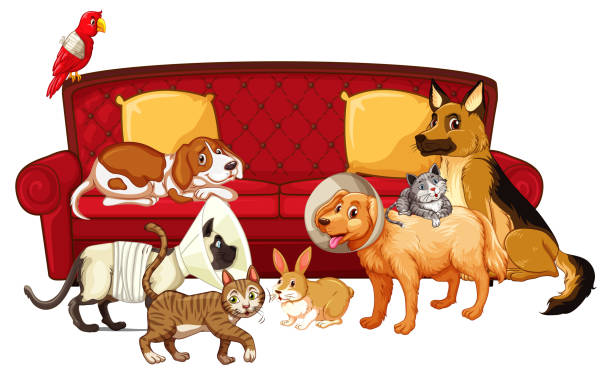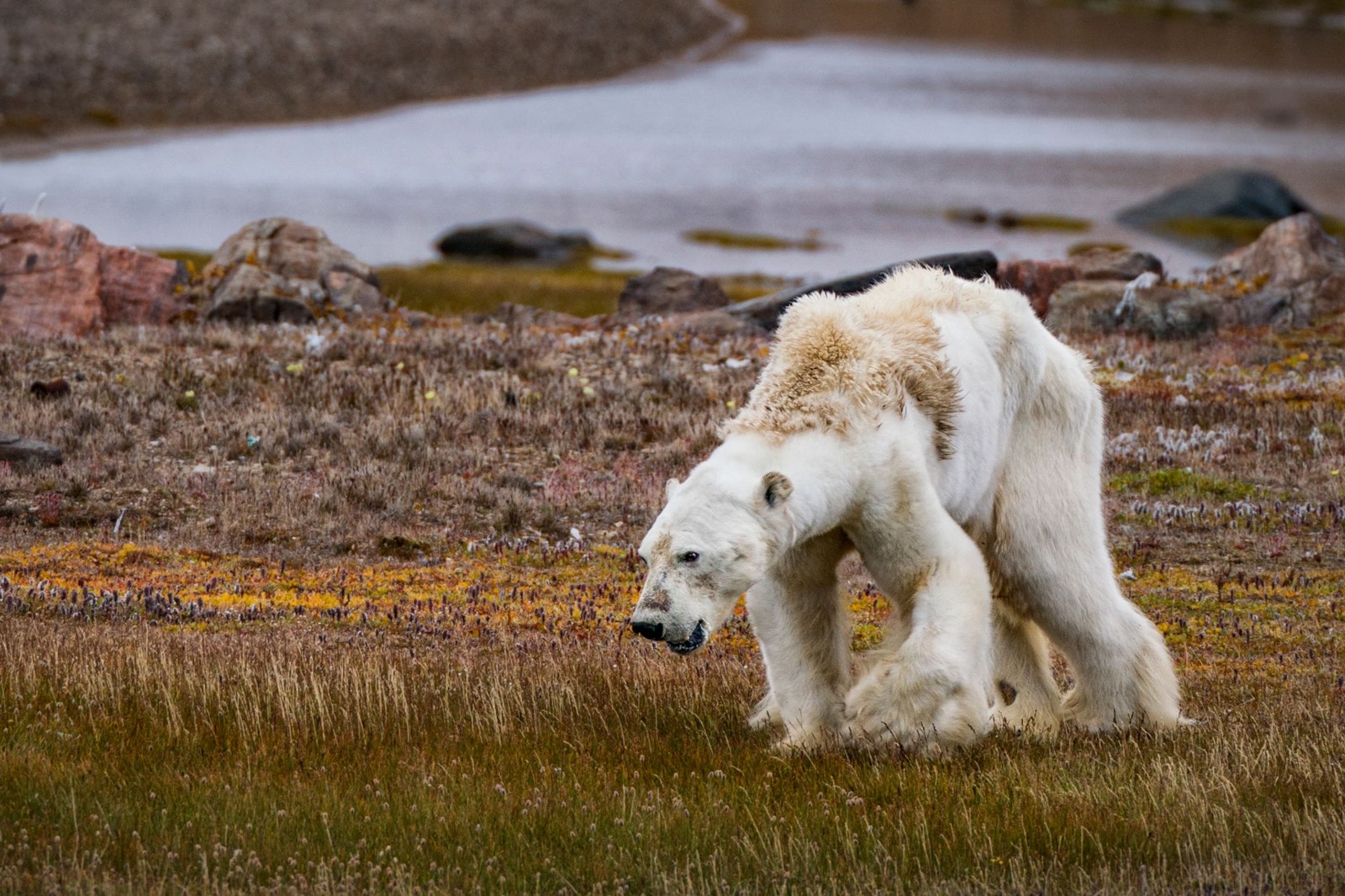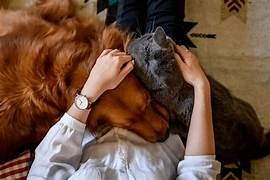
What If Pets Had Their Own Clubs? Imagining Secret Animal Societies
What if pets had their own secret societies? This article delves into the amusing and imaginative world of pet clubs, exploring how pets might organize, what activities they’d engage in, and why it’s fun to think about.
🐶 Pet Star
50 min read · 6, Mar 2025

Introduction: The Curious World of Pet Societies
Have you ever caught your dog looking at you with an expression of deep thought, as if they were plotting something? Or perhaps your cat, perched on their favorite spot, seems to be holding secret meetings with the neighboring cat? Imagine if our pets had their own clubs, hidden from human sight but buzzing with activity and purpose. What if they came together in a secret society, complete with their own rules, rituals, and social structures?
This article ventures into the whimsical possibility of what life might look like for pets if they were part of their own secret societies. We’ll explore how pets might organize their clubs, the potential roles within these groups, what activities they would engage in, and the secret codes they could use. It’s a fun exploration of the personalities, instincts, and quirks that pets exhibit in their everyday lives, reimagined in a fictional, club-like context.
While it may sound like an outlandish thought experiment, imagining pets in their own exclusive societies offers insights into their behaviors, relationships, and the fascinating way they interact with the world around them. So, let’s take a dive into this imaginary realm of pet clubs, where your dog could be the president, your cat the secretary, and your hamster, the treasurer!
The Basics of Pet Societies: What Would They Look Like?
Before we get into the specifics, let’s establish what a pet society might actually look like. After all, pets don't have the same social structures as humans do. They communicate with their bodies, sounds, and smells—so how could that translate into a society? Could they organize? Could they create traditions, rituals, and even rivalries? Let’s break it down.
Animal Intelligence and Social Structure
First and foremost, animals like dogs, cats, and even smaller pets like hamsters and rabbits have different levels of intelligence, social needs, and abilities. Dogs, for instance, are pack animals by nature. Their social structures are often hierarchical, with clear leaders and followers. Cats, on the other hand, are more independent, often creating smaller territories that they defend fiercely, but they can also form loose, cooperative bonds.
If pets had clubs, their organizational structures would likely reflect these innate tendencies. A dog club might have a strong leader, or "alpha," whereas a cat club might focus more on cooperation or stealth. These pets would form groups based on shared interests, instincts, and behaviors—perhaps with certain rules to determine membership.
Pet Club Roles: Who Would Be in Charge?
Every society has its leaders, and pets would be no different. Who would lead these animal societies, and what roles would they have? Would dogs take charge in a hierarchical manner, while cats formed a more laid-back and mysterious group?
Dogs: The Natural Leaders
Dogs, with their loyalty and pack mentality, would likely form a club with strong leadership at its core. In the dog world, there is often one dominant figure who leads the pack, and this could translate into a pet society where one dog takes on the role of president. The president would likely be a breed known for its protective instincts or high intelligence—think German Shepherds or Border Collies.
Beneath the president, there could be a series of other roles such as vice president, security (bouncers of sorts), and “advisors” (dogs with particular skills, like herding or guarding). These roles would all be geared towards maintaining order and running the club, ensuring that the dog society functions smoothly.
Cats: The Secretive Organizers
Cats, in contrast to dogs, are often seen as more independent and solitary creatures. However, that doesn’t mean they couldn’t form their own society. A cat club would likely be shrouded in mystery, with an enigmatic leader—possibly an older, more experienced cat with great cunning, like the Siamese or Maine Coon.
The cat society would likely be much more fluid, with less rigid structure and more subtle forms of hierarchy. It’s easy to imagine a cat society where the members constantly vie for the top position in a silent competition of stealth and intelligence. Cats might also have roles for scouts (cats who watch over the neighborhood and gather intel) and spies (who sneak into the homes of humans to learn their secrets).
Pets and Their Unique Social Clubs: Activities and Rituals
Now that we know how pets might organize their societies, let’s look at the activities and rituals that could play a part in their secret clubs. Every society, no matter how secret, has its traditions. Here’s a peek at some activities and rituals pets might engage in within their clubs.
Dog Clubs: Herding Competitions and “Barking Ceremonies”
For dogs, the activities in their clubs might revolve around the things they love best: play, exercise, and, of course, food. Herding competitions could be a common practice in dog societies, especially for working breeds like Collies or Australian Shepherds. These competitions would be a source of pride, showcasing their intelligence and agility.
Additionally, dogs may hold "barking ceremonies," where they gather in the park or backyard to practice their howls, growls, and barks. This could be a bonding experience for dogs in the society, strengthening their leadership structure and encouraging group cohesion. There could even be rituals involving the “hunt” for a favorite toy or the challenge of breaking into the “treasure chest” (aka the treat jar).
Cat Clubs: Stealth Games and Territory Marking Rituals
Cats, being the quiet and calculating animals they are, would likely enjoy more stealth-based activities. These could include agility challenges where cats navigate complex obstacle courses without making a sound, or secretive missions to “steal” items from humans (like socks, pens, or snacks).
Territory marking would also play a big part in cat club rituals. Members of the society would gather in their favorite spots—window sills, high perches, or under the bed—to mark their territory with scent and paw prints. This could even be a social event in itself, where cats compete for the best territory or the most discreet marking.
Other Pets and Their Secret Societies: A Broader Perspective
While dogs and cats would naturally dominate the pet club scene, what about smaller animals? Could hamsters, guinea pigs, or rabbits have their own clubs as well?
Hamsters: The Miniature Secret Agents
Hamsters, being small and agile, would have their own unique club. It could be based around secretive missions and intelligence gathering. Imagine a group of hamsters setting out on nighttime adventures in their tiny wheel-driven vehicles. Their activities might involve navigating through mazes (in search of food, of course) or gathering materials for their burrows, all while avoiding detection by their human companions.
Rabbits: The Peacekeepers and Diplomats
Rabbits, with their peaceful nature and strong social bonds, would likely form a very cooperative and harmonious society. Their activities could revolve around peacekeeping, ensuring the safety of their burrows and territories. They might also hold social gatherings where they share stories, nibble on fresh hay, and practice their skills in communication. Rabbits might even have special “alliance meetings” with their guinea pig counterparts, forging alliances for shared resources.
Pet Clubs and the Human Element: What Would We Know?
While pet clubs might operate in secret, humans would inevitably be involved in some way. As much as pets might want to keep their societies hidden from their human companions, there are always those moments when their club activities or behaviors could be inadvertently revealed. Let’s explore how these secret societies might interact with humans and how we might notice subtle signs of their secret lives.
Humans as Unwitting Participants
It’s impossible for humans to not notice when their pets are engaging in peculiar behaviors. Dogs might start running in circles before abruptly stopping, as if a secret meeting was about to take place. Cats might suddenly seem more “sophisticated” and aloof, perhaps as a sign they’re trying to maintain their position within the societal hierarchy. But could pets ever truly keep their secret societies a secret from us?
There’s always a possibility that pets could create “human-safe zones” where certain activities occur without the prying eyes of their owners. For example, a group of dogs might gather behind the couch for their weekly “howl session” without any human realizing. Cats, on the other hand, may use high surfaces and dark corners to plot their next moves, ensuring they stay well-hidden.
The Not-So-Secret Pet Hierarchy: Dogs vs. Cats
If pets had clubs, one of the most fascinating dynamics would be the ongoing rivalry between dogs and cats. Both animals have a long-standing history of competing for dominance in the home and even in larger social structures. If they had their own clubs, these two species would likely find themselves at odds over power and control.
Dogs, with their loyalty, protective instincts, and strong pack mentality, would likely see themselves as the natural leaders of any pet society. They might view themselves as protectors of the household, ensuring safety and order in the pet world. Cats, on the other hand, would prefer a more subtle approach, relying on wit, stealth, and cunning rather than brute strength.
Imagine a high-stakes “competition” between the two—dogs organizing a grand chase event versus cats holding a strategic stealth game. Tensions would run high, but at the end of the day, each side would value their own traits and abilities, contributing to the rich and varied dynamics of the club world.
Humans as the “Honored Guests” in Pet Societies
In rare instances, pets might invite humans to their meetings as special “honored guests.” These invitations would be bestowed with great care, with dogs selecting their favorite human for a “special mission,” such as the retrieval of a particularly elusive treat. Cats might choose to allow their humans to partake in a “catnip ceremony,” where they offer the human a symbolic seat at the table—well, perhaps at the foot of the chair.
Humans, however, might not fully understand the purpose of these invitations. They might find themselves perplexed when a cat nudges them to the window, seemingly sharing a quiet moment of reflection, or when a dog offers a playful tug-of-war with their favorite toy as if it were some kind of club initiation ritual. These moments would remain a mystery to us, though we might occasionally feel we’re in on some grand, secret joke.
The Unseen Rivalries: Pets and Other Animals in Their Clubs
Though dogs and cats would dominate the pet society landscape, there are countless other pets who might want to form their own clubs as well. Think about the smaller animals—birds, hamsters, rabbits, and even reptiles. What kind of societies would they form?
Bird Clubs: The Sky’s the Limit
Birds, whether they’re parakeets, cockatoos, or macaws, are often seen as social animals. In a world where pets form secret societies, birds would likely have their own sophisticated clubs, organized based on their species. Parakeets might have a more relaxed club with daily socializing and a focus on songs and aerial displays. Macaws, being larger and more colorful, might form a prestigious “elite” club, with high-ranking positions for the most charming and vocal members.
Birds would likely engage in activities like synchronized flight shows, vocal competitions, and even “treasure hunts” where they search for seeds hidden in various parts of the room. These clubs would be filled with a sense of beauty and display, showcasing their vocal talents and acrobatic skills.
Small Mammals: Hamsters and Guinea Pigs as the Plucky Underdogs
Hamsters and guinea pigs, while often overlooked, could have the most quirky and entertaining societies. Their clubs would likely revolve around the concepts of small-scale exploration and teamwork. Picture a hamster society that holds daring nighttime escapes from their cages, navigating through mazes and tunnels that would impress even the most skilled explorers.
Guinea pigs, being naturally social creatures, might form tight-knit communities where members share food, comfort each other, and discuss the best ways to avoid being picked up by their humans. Their meetings would likely consist of group chats, burrowing in soft bedding, and perhaps even fashion contests where they compete to see who wears the fluffiest fur.
Reptile Clubs: The Mysterious and Silent Leaders
Reptiles, such as lizards, snakes, and turtles, would likely form a more enigmatic, quiet club—one that values patience and silence above all else. Their meetings would probably consist of long hours basking in the warmth of lightbulbs or engaging in silent, slow-moving “territorial battles.”
While less outwardly social, these reptiles would likely have a deep sense of hierarchy. A large, ancient turtle might hold the title of “grand elder” of the society, while younger, more agile lizards or snakes would act as protectors or scouts.
Pet Clubs in the Future: An Imaginative Exploration
As technology advances, it’s fun to imagine how pet clubs might evolve in the future. Could there be pet-only virtual spaces, where animals communicate through signals, scents, and movements that we can’t detect? With the rise of pet cameras, sensors, and even artificial intelligence, the possibilities are endless. Perhaps pet societies of the future will be even more sophisticated, with “virtual” meetings taking place via pet communication devices or complex sensory channels.
While this might sound far-fetched, the idea of pets forming societies, communicating in ways beyond our understanding, and organizing into secret groups is a whimsical reflection of the love and mystery we hold for them. These animals, after all, have their own personalities, instincts, and unique ways of interacting with their worlds.
Conclusion
Imagining a world where pets form their own secret societies is a whimsical yet fascinating exercise in creativity. While the concept may be playful, it also sheds light on the rich diversity of animal behavior and the intelligence of our pets. Dogs, cats, birds, and even smaller pets like hamsters and guinea pigs all have unique social structures and instincts, which could translate into incredibly varied and imaginative pet societies. These clubs could range from the highly organized and hierarchical dog societies to the laid-back, stealthy cat gatherings, and the more peaceful, community-driven rabbit and guinea pig groups.
The activities, rituals, and hierarchies within these societies would reflect the inherent traits of each species—whether it's dogs showcasing their loyalty and athleticism, cats indulging in their secretive, tactical behavior, or birds showing off their beauty and vocal prowess. Even smaller pets like hamsters and reptiles would have their own ways of bonding and organizing, though more subtle and quiet than their canine or feline counterparts.
While we can never fully know what goes on behind the mysterious behaviors of our pets, imagining them in secret societies helps us appreciate the complexity of their personalities and relationships. Whether it's the ongoing rivalry between dogs and cats or the possibility of bird societies engaging in flight displays, the idea of pet clubs gives us a playful way to connect with our animals on a deeper, more imaginative level. So, the next time your pet does something strange or unexpected, remember—they might just be preparing for their next secret meeting!
Q&A
Q: Why do pets seem to act in ways that suggest they have secret lives?
A: Pets, like dogs and cats, exhibit complex behaviors driven by their instincts, social structures, and personalities. While they don't have "secret societies" in the human sense, their actions often appear mysterious, leading us to imagine that they may have hidden lives.
Q: Could pets really have organized societies?
A: While pets can't organize societies in the way humans do, they do have social behaviors and hierarchies. Dogs, for example, have pack structures, and cats can form loose social groups, suggesting that they could, in theory, organize in their own way.
Q: What would the leadership structure in a dog society look like?
A: In a dog society, the leadership would likely be based on a dominant "alpha" dog, reflecting their natural pack mentality. The alpha dog would guide the group, and there would be subordinates who follow.
Q: How would a cat society differ from a dog society?
A: A cat society would likely be more independent and fluid. Cats don't have the same pack mentality as dogs, so their societies might involve more subtle power dynamics, with different cats asserting dominance in various ways without a strict hierarchy.
Q: How do smaller pets like hamsters and guinea pigs fit into these societies?
A: Smaller pets like hamsters and guinea pigs might form quieter, more communal societies. Hamsters may organize into secretive burrow networks, while guinea pigs could create closely-knit social groups centered around food-sharing and mutual grooming.
Q: Would pets from different species form alliances?
A: Absolutely! Dogs and cats, despite their rivalries, might form temporary alliances in the event of a common threat or need for resources. Similarly, a hamster could join forces with a guinea pig for a shared "mission" of food collection.
Q: What rituals might pets have in their societies?
A: Pets could have rituals based on their instincts. Dogs might hold competitions for agility or loyalty, while cats could have marking or stealth rituals. Hamsters might participate in maze challenges, while birds could have vocal competitions.
Q: Could pets create their own form of communication in their clubs?
A: It's certainly possible! Dogs already communicate with barks, growls, and body language, while cats use meows and body signals. If they formed clubs, they might develop more complex ways of communicating, such as specific calls or movements tied to their society's activities.
Q: How do human owners fit into these secret pet clubs?
A: While humans might not be members of these pet clubs, they would likely be seen as the “honored guests.” Pets could include their humans in certain activities, like retrieving food or providing treats, but always maintaining an air of mystery about their true club activities.
Q: Is this idea just for fun, or does it reveal something deeper about our pets?
A: While the idea of secret pet societies is mostly for fun and creative imagination, it does shed light on the complexity of our pets’ behavior. They are intelligent, social creatures with distinct personalities, which we may not always fully understand. Imagining their secret societies gives us a way to appreciate them on a new level.
Similar Articles
Find more relatable content in similar Articles

How Climate Change Affects Wild and Domestic Animals...
Climate change is dramatically.. Read More

The Growing Trend of Therapy and Emotional Support Ani..
Exploring the remarkable rise .. Read More

How Pets Strengthen Family Bonds...
Pets are more than just compan.. Read More

Pets and Mental Health: The Science Behind Emotional H..
Discover the profound impact o.. Read More
Explore Other Categories
© 2024 Copyrights by rPets. All Rights Reserved.